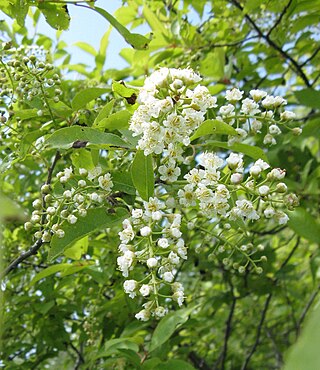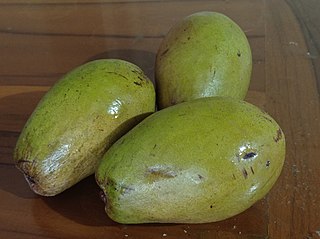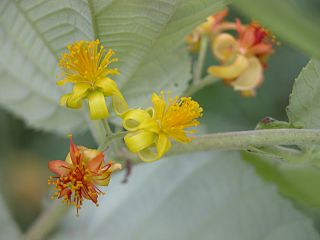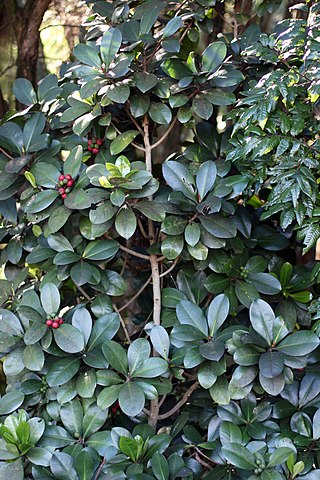
Melicoccus bijugatus is a fruit-bearing tree in the soapberry family Sapindaceae, native or naturalized across the New World tropics including South and Central America, and parts of the Caribbean. Its stone-bearing fruits, commonly called quenepa, ‘’’kenèp’’’ or guinep, are edible. Other names for the fruits include limoncillo, Bajan ackee, chenet, Spanish lime and mamoncillo.

Prunus virginiana, commonly called bitter-berry, chokecherry, Virginia bird cherry, and western chokecherry, is a species of bird cherry native to North America.

Cornus canadensis is a species of flowering plant in the dogwood family Cornaceae, native to eastern Asia and North America. Common names include Canadian dwarf cornel, Canadian bunchberry, quatre-temps, crackerberry, and creeping dogwood. Unlike its relatives, which are for the most part substantial trees and shrubs, C. canadensis is a creeping, rhizomatous perennial growing to about 20 centimetres tall.
Mallotus cumingii is a species of plant in the family Euphorbiaceae. It is native to Southeast Asia, occurring in Indonesia, Malaysia, and the Philippines. It is a shrub or small tree growing to 25 m (82 ft) tall.
Mallotus pleiogynus is a species of plant in the family Euphorbiaceae. It is a tree that grows to 43 m (141 ft) tall and is native to New Guinea.

Prunus maritima, the beach plum, is a species of plum native to the East Coast of the United States. It is a choice wild edible and its few pests and salt tolerance make it a resilient fruit crop for degraded lands and urban soils.

Mangifera caesia is a species of flowering plant in the cashew family, Anacardiaceae. Known in English as jack or white mango, among other names. It belongs to the same genus as the mango and is widely cultivated in areas of Indonesia, Malaysia, Singapore, Brunei, Papua New Guinea and the Philippines.

Grewia asiatica, commonly known as phalsa or falsa, is a species of flowering plant in the mallow family Malvaceae. Grewia celtidifolia was initially considered a mere variety of phalsa, but is now recognized as a distinct species.

Elingamita is a genus in the plant family Primulaceae. It consists of a single species, Elingamita johnsonii, a tree or shrub endemic to the Three Kings Islands approximately 55 km north of the North Island of New Zealand. The entire world natural population of the tree is confined to a small rocky island and two nearby islets, and thus is vulnerable to destruction by fire or other unforeseen events. Elingamita johnsonii grows as a shrub or small tree in pōhutukawa forest and coastal scrub on West island. It also occurs on two rocky islets of the Princes Group; on one of these islets, Hinemoa Rock, it grows as an emergent canopy tree in exposed places. The relationship of Elingamita to other genera of the Primulaceae remains to be properly established. Discovered in 1950, Elingamita johnsonii takes its name from the steamer Elingamite, which was wrecked on West Island in 1902. The natural range is currently free of rodents, but the fruit is known to be very palatable to rats.

Dillenia indica, commonly known as elephant apple or ou tenga, is a species of Dillenia native to China, India, and tropical Asia. It is found in stony river banks.
Canarium pseudodecumanum is a tree of tropical Asia in the incense tree family Burseraceae. The specific epithet pseudodecumanum is from the Latin meaning "false decumanum", referring to the species' resemblance to Canarium decumanum.
Kibara coriacea is a plant in the family Monimiaceae. The specific epithet coriacea is from the Latin meaning "leathery", referring to the leaves.

Mangifera pajang, commonly known as wild mango, is a species of tree in the family Anacardiaceae. It is endemic to Borneo, where it is known by the various native names: buahbambangan, buah mawang and buah embang.

Mangifera zeylanica or "Sri Lanka wild mango" is a wild species of mango tree endemic to Sri Lanka. This stately tree is the tallest member of the mango genus, Mangifera, and one of the two tallest trees in the family Anacardiaceae. The mango fruits are edible and have an excellent taste. It is called "aetamba" (ඇටඹ) or "wal amba" in Sinhala and “kaddu-ma” in Tamil. The well-known British botanist and explorer Joseph Dalton Hooker first described the tree in 1876.

Maranthes corymbosa is a tree in the family Chrysobalanaceae. The specific epithet corymbosa is from the Greek meaning "cluster", referring to the clustered inflorescences.

Metroxylon sagu, the true sago palm, is a species of palm in the genus Metroxylon, native to tropical southeastern Asia. The tree is a major source of sago starch.

Mangifera indica, commonly known as mango, is an evergreen species of flowering plant in the family Anacardiaceae. It is a large fruit tree, capable of growing to a height and width of 30 m (100 ft). There are two distinct genetic populations in modern mangoes – the "Indian type" and the "Southeast Asian type".

Leuenbergeria bleo, formerly Pereskia bleo, is a leafy cactus, native to the shady, moist forests of Central America, that grows to a woody, prickly shrub about 2 m tall with large, orange flowers resembling rose blossoms.

Drypetes gerrardii is a species of small tree or large shrub in the family Putranjivaceae. Common names include forest ironplum, bastard white ironwood, and forest ironwood. It is native to tropical and subtropical central and eastern Africa. It was first described in 1920 by the English botanist John Hutchinson, who named it after the English botanist William Tyrer Gerrard who collected plants and seeds in southern Africa in the 1860s.
Heliciopsis artocarpoides, also known as kurunggu or putat, is a species of flowering plant, a tropical forest fruit-tree in the macadamia family, that is native to Southeast Asia.
















